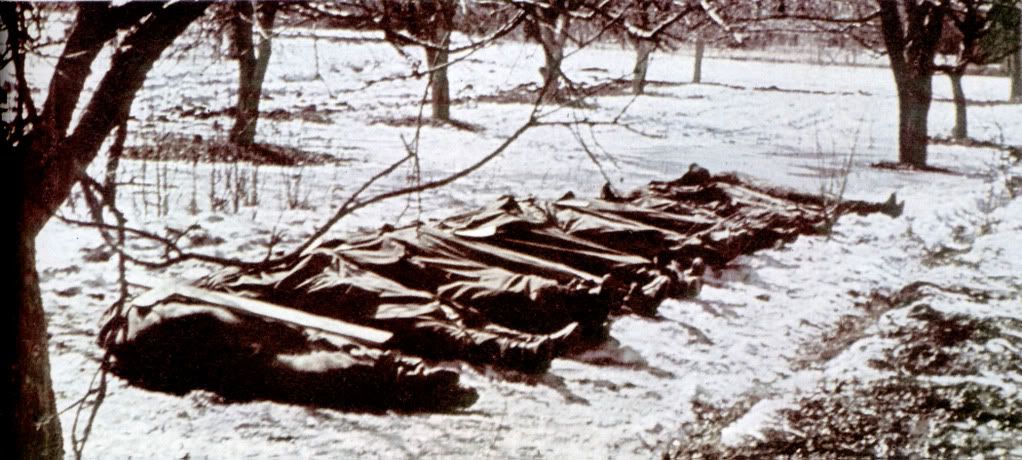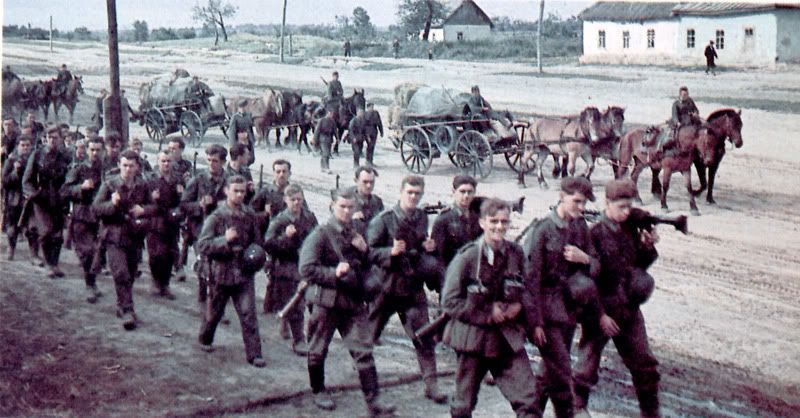Thank you! 
The Second World War still has weighs on many people, more than 60 years after it came to an end. As we all know, honorable ladies and gentlemen, real war is not a game – and war’s real costs and consequences never can be declared sufficiently and apparently. Sorrow is the natural human response to death, and the full factographic expression of the verity of war may be war’s most natural and effective deterrent.
This rare color photography is a truth force that says: “This is what war looks like”. Simply and undeniably.

The remains of Wehrmacht soldiers are awaiting proper springtime burial on a deeply frozen layer of the Soviet soil – vicinity of Volokolamsk, November 1941. Picture taken by Dr. Alfred Ott
Not funny but rare indeed.
This is definately the most rare headgear ever used by a german pilot. :shock:
JG 52 in Rumania 1941.

Himmler and some of his ‘serious guys’ collecting flowers.

Well. that is almost funny. :shock:
Pretty awesome pics
It would be if they were actually in a minefield at the time :mrgreen:
Funny and fair enough I guess.
noted that the photo is from a website that looks to be Hungarian? anyone know a better source for the image I’dlove to get more background and use it in the magazine I work for.
Very nice foto’s!!Thank you very much!!Sorry for my bad English…:roll:
Oh, your english is no so bad, thanks man. 
BMW stunts.

Ein fallschirmjäger ist kaput…

The siesta of a Fox, Desert Fox.

How’d those guys get their hats to stay on???
As we all know, honorable ladies and gentlemen, winter is a bed time for fighting. The nights are freeying cold, the ice-cold rain or snow seldom lets up, the battlefields are oceans of mud, or frozen snow-slurry…
The stakes of the winter battle are large and the losses are bound to be dramatically heart-rending. But perhaps there is nothing more dramatic in entire military history of the world than the stunning assault of the cold on the Wehrmacht in the Russian Campaigne.
The magnificent weather which favoured the German offensive at dawn on October 2nd 1941 was followed, a few days later, by a long period of rains, sometimes mixed with snow. From October 20 onward, the German armies were literally wading in the mud of the steppes. Off the roads the terrain was generally impassible and, with rare exceptions, the roads themselves were dreadful sloughs where vehicles were seen to completely disappear. All the rivers were in flood, which made it a long and difficult operation to repair the countless bridges that the Soviets had destroyed in their retreat.
There is abundant photographic evidence to illustrate this phase of the campaign and it shows mud up to the hubs of German vehicles, up to the bellies of their horses, and over the knees of their soldiers. Suddenly, the drop of temperature was far greater than expected, and was untolerable toward the realization of the tasks required by OKW. On November 12, the temperature was -12 degrees of Centigrade, the following day -13 degrees and, on December 4, the mercury fell to unbearable -35 degrees with a strong north-east wind that made the biting cold even more painful. As we all know, winter equipment was ordered too late, delayed on its way to the front by the effect of the cold on German locomotives… Badly worn by five months in the field, the clothing of the German soldier was, in any case, not at all suitable for the rigors of the Russian winter… This rare color photo, however, speaks for itself about those well known conditions.

The crew of a PzKpfw III is trying to melt out the frozen mud around their tank by bucketing hot water – December 1941, vicinity of Mozhaisk, photo taken by Dr Eugen Ott
Due to lack of antifreeze German engines had to be left running all the time, which meant a considerable increase in engine wear, as well as significantly augmented fuel consumption. Crampons for the tank tracks had not yet reached the front, and the tracks were too narrow to carry the tanks over the deep snow. Automatic arms jammed during combat and guns did not recoil properly after firing. Parts made out of synthetic, butadiene-sodium based German Buna-rubber, became friable and took on the consistency of wood. In these conditions, the motorised army-supply columns were able to cover only 20 miles a day, or even less…
Auxiliary horse transportation companies, hurriedly prescribed by German headquaters and applied on a spur of the moment by German troops were only a temporarily solution, because the army’s livestock suffered terribly too. It was generally unknown that the German horse does not have the same resistance to the harsh Russian climate as his Russian cousin, who was accustomed to scratch out grass with his hoof.
It was in the depth of winter, and the march of the transportation columns through the heavy, snowy roads, were very trying and wearisome; But the soldiers and animals endured all… somehow.

December 1941 - March of the German transportation column through the Soviet village on a frozen, snowy road - photo taken by Dr Eugen Ott
Pretty handsome, pastoral New Year’s décore indeed… :roll:
How’d those guys get their hats to stay on???
Those are glued perhaps ?
The crew of a PzKpfw III is trying to melt out the frozen mud around their tank by bucketing hot water – December 1941, vicinity of Mozhaisk, photo taken by Dr Eugen Ott
Well, that tank is going to need a lot of hot water !! :shock:
That is the donkeyfaust anti- partisian weapon system used in Italy. Seriously.
Were did you get those?
You mean those color pictures from the German winter campaign, mein lieber Herr Major? They are originating from a half-forgotten Yugoslavian edition of the “Picture History of World War II”, printed in 1970 by „Mladinska Knjiga”, Ljubljana under the license provided by American Heritage Publishing Inc., and originally published in English in 1966 (pp. 276-277).
This one, however, derives from the page 349:

Advancing German infantry – USSR, September 1941.
BTW: I think that I have seen before that highly appealing signature of yours… If I remembered that well, it was created by a truly remarkable and absolutely unique personality, who was my personal adviser about German armored vehicles – a genuine, matchless celebrity of the German part of the Internet, who always signed his posts with that distinctive expression “Mit besten Schwermetallgrüßen”… Are we, by any chance, honored with his personal visitation here, my dear Herr Major? 
Man on TriCycle :]

